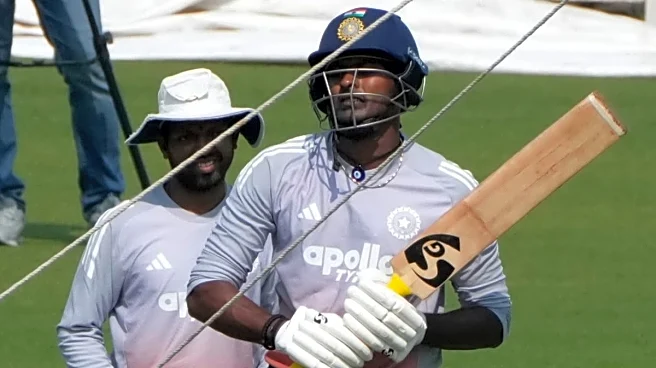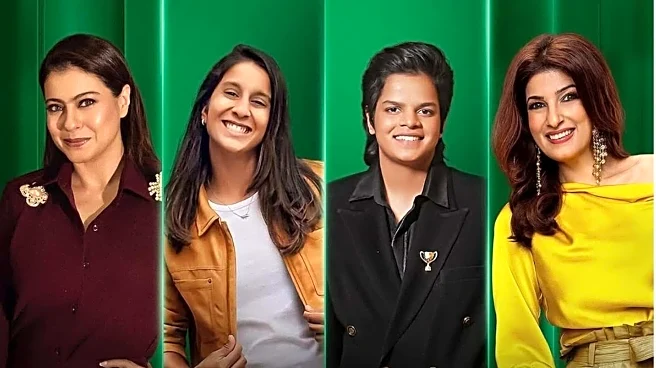For exactly five seconds after Harmanpreet Kaur took that catch to get that wicket of Nadine de Klerk to seal that World Cup final night in India’s favor in Navi Mumbai, there was silence on air. All we
heard was Richa Ghosh’s typical ‘Yeahh’ in the stump-mic, the clattering runs and collapses into each other of the 11 Indian women on the DY Patil Stadium field, and a couple of muffled ones from two in the Hindi commentary box.
Then, after the brief break, came the monologue: “Saare jahan se accha, Hindustan humaara. Naya vijetha mila hai is vishwa ko aur vo vijetha hai Bharat. Bharat ke paschim mein, raat ke andhere mein, ek naye Surya ka hua hai uday. Aur us Surya ki chamak se chaka-chaund hojayega puura vishva. Ye jeet sirf in ladkiyon ki nahi hai, ye jeet kahi barson ki, kai dashakon ki tapasya ki hai, mehnat ki hai, mashaqqat ki hai. Ye jeet har us ladki ki hai jise sapne dekhne se roka gaya tha, jis ko aage jaane se toka gaya tha.”
Aakash Chopra, the only man in the Hindi commentary box at the time, held forth and spoke his heart out, somehow giving just the right words to a moment forever etched in Indian history. He mentioned how in the dim of the night in India’s West, a sun had risen that would brighten the world, even as the rest of the Indian squad members and support staff came running in for more hugs, more tears, more celebration.
He could have left it at that. But he went on to say how that this win wasn’t just of these 11 women, but of the years of hard work and penance. He said it wasn’t just for these 11, but for every girl who was stopped from seeing her dream, and every girl who was taunted about trying to realise a dream.
As one of the first male pundits of standing to be roped in to cover the women’s cricket revolution in India, Chopra had seen the journey the team had gone through in the last half-decade. And he had also seen the decency their male counterparts enjoyed at the bare minimum — how not every loss was met with taunts to give up the sport and return to the throes of patriarchy because that’s what they ‘deserved’.
“I was thinking, what does it mean? What does it mean for women’s sport?” Chopra recalls the moment in a long and detailed chat with News18 CricketNext after the final. “Because if you just look around, you will find there is too much discrimination. You realise that this win is far more symbolic and significant as compared to just another cricket match.”
“When India lost the game against England… I saw lots of memes of Smriti (Mandhana) and Harmanpreet Kaur in the kitchen… I thought, yaar, it is not right because would you do that to an Indian men’s team? India men also lost the 2022 World Cup semi-final… But I did not see anybody saying, ‘Why are you playing cricket?’ Men would not go through that kind of criticism. And that is when you realise that this actually means a lot more because Ladkiyon ko actually roka jaata hai, unko sapne lene se toka jaata hai yaar.”
“And I will be honest… after we won the semi-final, I knew that I would be calling the finals. So I started writing. I was wondering what would actually fit well. So, ladkiyon ka rokana, ladkiyon ka tokna, unki jet ko celebrate karna, acknowledge karna (celebrating and acknowledging the win). I thought that was almost necessary, that if I don’t capture that, then do I do justice? Because it is not just winning the World Cup; it is a lot more. I hope I actually spoke for every single girl who has gone through it,” he added.
View this post on Instagram
Chopra’s experience told him that India was destined to win when the asking rate was climbing on South Africa, even before centurion Laura Wolvaardt’s wicket. But the moment still surprised him, with how ‘surreal’ it was to feel the emotional force of something so predictable, hence that five-second pause.
“You just want to allow that moment to sink in for a little second, where you think, ‘Wow, a dream has been realised’ and you pinch yourself mentally,” he said.
Chopra said that as a broadcaster, he never demanded to cover women’s cricket but believes he was assigned the role early because the networks recognized his genuine investment in the sport. Women’s cricket has always excited him because it’s on the up and yet to hit its ceiling, unlike men’s cricket.
“Men’s cricket, in terms of skills and talent and temperament and everything—the physical aspect of athleticism, everything—it has already hit the ceiling. It cannot go further up. It is not possible. McCullum’s 175 will be equally relevant today and celebrated today because even today, you can’t make 175. The only difference you will find is that the camera quality has become better. But the quality of the game has not improved because there is hardly any scope,” he said.
“But with women’s sport, it actually looks like a different sport every 10 years. If you were to see 10 years ago, if you see any game from 2015 and you see today, you will find, ‘Wow, the game has changed so much, man.’ The first WPL and this WPL, you again see, ‘Wow, there are so many young Indian girls who are now making a mark and they are actually as good as some of the best international players.’ And you see progress. You see that there is potential, and the potential is still not fulfilled. It will continue to grow.”
‘Chita ki aag toh thandi hone do’
Coming back to the World Cup, there were many excellent individual performances for India. Chopra became ‘a fan of Pratika Rawal,’ praising her unique timing and placement of shots, especially given the challenge of smaller gaps in the inner circle in women’s cricket.
He found Shree Charani as an ‘outstanding’ left-arm spinner, calling her ‘one for the future’ and noted Shafali Verma’s impactful final, highlighting her improved mindset and the ‘hunger ‘ she showed after a long absence from the team.
But he agreed with Harmanpreet’s post-final comments that this was just a start. That, no matter what the emotions might want to suggest us, this World Cup can’t be a pinnacle for this team. That, the five-wicket win over Australia in the historic semi-final would probably not play out the same way seven times out of ten.
“I think there is a lot of scope for improvement,” he said. “I don’t think it is a perfect team. We are the world champions… saare jahan se achcha toh hum hai, but the truth is also that there is a lot of work still to be done. Australia is miles ahead. Losing one game in 8 years… they are that good. As I said, this victory is the hard work of decades, that struggle, that penance of Mithali Raj, Jhulan Goswami, and Anjum Chopra. Now there will be new faces, but we still have a fair amount of distance to travel before we start beating Australia regularly, and the path again will go through the WPL way as well… the only way is up.”
But, for balance, he also disagreed with the legendary Shantha Rangaswamy, who wanted Harmanpreet to step down from captaincy immediately after the final and make way for Mandhana to take over across formats.
“I will give you an example. It’s a slightly different example, but just because I have just been to Kashi, there’s the Manikarnika ghat nearby, which is basically a cremation ground. I want to say, chita ki aag toh thandi hone do yaar abhi, (Let the fire of the pyre cool down first, man).”
“Let them just garner the limelight and every single appreciation and adulation that’s coming their way. There is time to think. Yes, a World Cup is going to happen, but it is going to happen next year; it is not happening this year. So there will be a time when you will say, ‘Okay, yes, it is done,’ and now we will move on. But abhi rehne dete hain yaar (But let it be for now, man).”
He also defended coach Amol Muzumdar against early tournament criticism, explaining that while fans questioned team combinations — like the extra batting depth idea that didn’t work, or the decision to keep Jemimah Rodrigues in the middle-order — a coach cannot unilaterally impose decisions on a senior captain.
He feels that with a clear succession plan and better alignment between the new selection committee, the captain, and the coach, Indian women’s cricket is well-positioned for the future.
‘Nation’s appetite for the sport has been ignited’
So, isn’t it the best time to invest further in women’s cricket? Not just because the trolls will remain quiet about their ‘cut the salaries’ taunt for a while, but also because there’s no better time to encourage inspired girls to take control of their dreams?
“I think it is already happening, the value of money being pumped into a sport. When the WPL auction was happening, I don’t think there were many takers. But now you will find that the pie is getting bigger, and you will find more investment,” Chopra said. “The WPL—now that the wheel is set in motion, it will continue to grow. No doubt we need improvement at the school level. Most of the World Cup-winning members went to all-male academies… There, you treat them a little specially and separately. I hope all-women’s academies will happen now, and that is down to the parents and the kids to get excited enough, and that is why you needed this moment. It ignites a nation’s appetite for the sport. Suddenly, parents will be more inclined, suddenly, kids will be more inclined, and therefore the investment will flow. Money follows a product that is garnering attention. Everything takes care of itself after a mass revolution,” he added.
This win was always for more than the 16 squad members. It showed how the team celebrated it with Mithali Raj, Jhulan Goswami, and Anjum Chopra. However, the impact goes even beyond that. There’s hope that this win opens the gate for women in the commentary and broadcasting houses, too.
“I really hope that happens. Why? Because these girls actually know the stories far better. See, we are living on borrowed knowledge. But women, actually, they’ve gone through it, they’ve seen it first-hand, they know their stories a lot better. It is their space. It belongs to them. We will just be embellishments,” he said.













